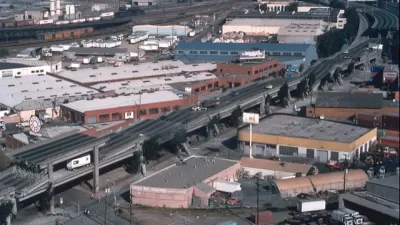Sunday's powerful Bay Area earthquake brought attention to the urgent need to retrofit existing buildings in California. One expert stated the damage in Napa "was predictable." Do you know the three types of construction that need to be reinforced?
"Experts have long known that three types of construction common in the state don't hold up well in quakes: brick or stone, those with "soft" stories—floors not well-reinforced—and certain kinds of concrete structures. In California, new construction of such buildings has been banned," writes Alejandro Lazo.
But such buildings haven't disappeared, and efforts to retrofit those remaining aren't uniform. The state leaves enforcement of such measures in the hands of local jurisdictions.
Lazo describes the retrofit required for each type of aforementioned construction. Napa had passed a 2006 ordinance requiring retrofit of unreinforced masonry. All but about six of these types of buildings had undergone retrofit when the quake hit.
Building damage was widespread nevertheless. "On Monday (August 25), the city of Napa said that 64 buildings had been tagged 'red' by inspectors as unsafe to enter. More than 100 were tagged 'yellow, meaning they require further inspection," notes Lazo.
Lucile Jones, a seismologist with the U.S. Geological Survey, who has been hired by the city of Los Angeles to evaluate its buildings, said the structural damage from Sunday's quake "was extremely predictable." Dr. Jones, who advises the state commission on risk reduction, added: "We now have to make a choice to do something about it before the next earthquake hits."
Correspondent's note on access to Wall Street Journal article: Subscriber-only content will be available to non-subscribers for up to seven days after August 26.
FULL STORY: Quake Raises Building-Safety Questions

Alabama: Trump Terminates Settlements for Black Communities Harmed By Raw Sewage
Trump deemed the landmark civil rights agreement “illegal DEI and environmental justice policy.”

Study: Maui’s Plan to Convert Vacation Rentals to Long-Term Housing Could Cause Nearly $1 Billion Economic Loss
The plan would reduce visitor accommodation by 25% resulting in 1,900 jobs lost.

Planetizen Federal Action Tracker
A weekly monitor of how Trump’s orders and actions are impacting planners and planning in America.

Wind Energy on the Rise Despite Federal Policy Reversal
The Trump administration is revoking federal support for renewable energy, but demand for new projects continues unabated.

Passengers Flock to Caltrain After Electrification
The new electric trains are running faster and more reliably, leading to strong ridership growth on the Bay Area rail system.

Texas Churches Rally Behind ‘Yes in God’s Back Yard’ Legislation
Religious leaders want the state to reduce zoning regulations to streamline leasing church-owned land to housing developers.
Urban Design for Planners 1: Software Tools
This six-course series explores essential urban design concepts using open source software and equips planners with the tools they need to participate fully in the urban design process.
Planning for Universal Design
Learn the tools for implementing Universal Design in planning regulations.
Caltrans
Smith Gee Studio
Institute for Housing and Urban Development Studies (IHS)
City of Grandview
Harvard GSD Executive Education
Toledo-Lucas County Plan Commissions
Salt Lake City
NYU Wagner Graduate School of Public Service





























